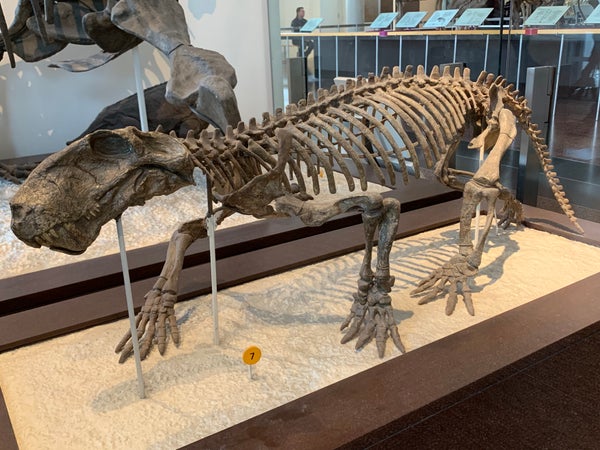This article was published in Scientific American’s former blog network and reflects the views of the author, not necessarily those of Scientific American
Prehistoric carnivores are larger than life. They often loom large in our imaginations – larger than they ever were in life – and fight so fiercely that they seem to be prime, perfect specimens or are suddenly dead in the jaws of another. It’s rare that we envision them wearing the scars and injuries that they must have acquired with time – the Allosaurus jimmadseni nicknamed “Big Al” has at least 19 pathologies from what must have been a very hard life, indeed.
And so it is with the sabertoothed gorgonopsians. These protomammal relatives of ours are often cast as Permian monsters made to order. A particularly large form of this strange carnivorous breed was a recurring villain on the show Primeval, and gorgonopsians remain cult classics within the fossiliferous fandom for their fierce appearance and presumably vicious eating habits. A little extra fang seems to glint with malevolent purpose. But these synapsids were not flawless killers. They dealt with injury, infection, disease, and the painful parts of life, too. A fossil described by Kyle Kato and colleagues is such a case study in Permian pain.
The fossil itself, simply known as NHCC LB396, looks a little gnarly. It’s a left lower arm bone of a gorgonopsian, with a bumpy bulge of bone jutting from the side. The pathology is identified by Kato and coauthors as an osseous lesion – or, simply, bone that has been damaged or altered. The most likely cause, the researchers propose, was an inflammation of the connective tissue around the bone – the periosteum – that was overlain by bone growth. Sometimes being a paleontologist is an excercise in ancient veterinary medicine.
On supporting science journalism
If you're enjoying this article, consider supporting our award-winning journalism by subscribing. By purchasing a subscription you are helping to ensure the future of impactful stories about the discoveries and ideas shaping our world today.
What caused bleeding and inflammation that led to the lesion isn’t clear. Determining the cause of an injury isn't always easy, even in a living patient. But it seems that the bone bulge formed within a year. That’s fairly fast, and indicates that this gorgonopsian – at least – had a bone physiology that was as reactive and quick as many dinosaurs and mammals. Gorgonopsians and other protomammals of their time were not creatures stuck between lizard and mammal, as old representations proposed. They were animals we have to understand on their own terms, and often seem relatively advanced for their time. How the body of this one sabertooth carnivore responded to injury stands as a preserved preview of what was to come.
